calsfoundation@cals.org
Official State Musical Instrument
aka: Fiddle
On February 28, 1985, the Arkansas legislature approved Act 277, designating the fiddle as the official musical instrument of the State of Arkansas. The designation, which originated as House Bill 749 sponsored by Representative Bob Watts of Harrison (Boone County), asserted that the instrument was “most commonly associated with the musical education and entertainment of the pioneer families of Arkansas and…continues as a dominant musical instrument in the culture…of the people of Arkansas.” Watts’s measure was supported in the chamber by Representative Napoleon Bonaparte “Nap” Murphy of Hamburg (Ashley County), who delivered a brief oration on the floor of the House on the history of the fiddle from medieval times to its modern form.
This official designation is a tangible acknowledgment of the primacy of the vernacular violin in early American musical life. The words “fiddle” and “violin” describe the same instrument, the highest-pitched of the viol family of unfretted stringed instruments. The fiddle’s design was effectively standardized by the mid-eighteenth century: a body shaped like an hourglass with a pronounced waist, an ovoid arched fingerboard, four strings usually tuned in intervals of perfect fifths, an arched bridge or string support, and a wooden tailpiece or string anchor. Any violin, when used for playing vernacular or “folk” music, is apt to be termed a fiddle, but some folk performers have modified their instruments by flattening the bridge, making it easier to play double notes or chords. The art of fiddling is promoted in Arkansas by local folk music societies, a handful of luthiers (violin-makers), and the state’s annual Old-Time Fiddling Championship, a competition and reunion of vernacular violinists held each autumn at the Ozark Folk Center in Mountain View (Stone County).
The violin, or fiddle, was perhaps the most commonly encountered musical instrument in the years of the United States’ westward expansion. The fiddle’s convenient size, relative robustness, high volume, and the ease of rudimentary apprehension made it well suited for carrying on long trips; even the musically challenged could manage to scrape out the rhythms of sacred and secular melodies for family, community, and congregational gatherings.
The fiddle’s association with Arkansas was made manifest in the humorous tale and song “The Arkansas Traveler.” Popularized by—and possibly originating with—Arkansas politician and raconteur Sandy Faulkner, the story turned on a “city slicker” proving his mettle to a rural squatter by demonstrating skill on the fiddle; the result is an overwhelming outpouring of hospitality. The tale was the subject of a painting by Edward Payson Washbourne that, in the form of chromolithographs published by both Grozelier and Currier & Ives, hung in thousands of American households in the mid-nineteenth century.
For additional information:
Goerzen, Chris. “George Cecil McLeod, Mississippi’s Fiddling Senator and the Modern History of American Fiddling.” American Music 22 (Fall 2004): 339–379.
Randolph, Vance, and Frances Emberson. “The Collection of Folk Music in the Ozarks.” Journal of American Folklore 60 (April 1947): 115–125.
Ware, David. It’s Official! The Real Stories behind Arkansas’s State Symbols. 2nd ed. Little Rock: Butler Center Books, 2017.
David Ware
Arkansas Secretary of State’s Office
 Arts, Culture, and Entertainment
Arts, Culture, and Entertainment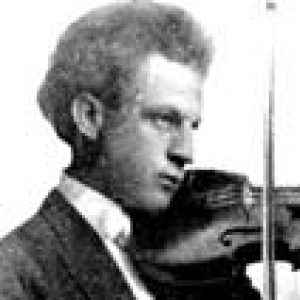 "Arkansas Traveler"
"Arkansas Traveler" 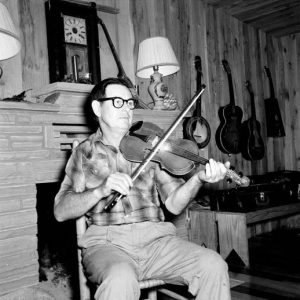 Jimmy Driftwood
Jimmy Driftwood 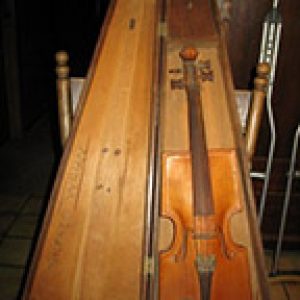 Fiddle and Case
Fiddle and Case 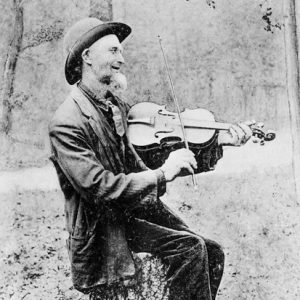 Fiddle Player
Fiddle Player 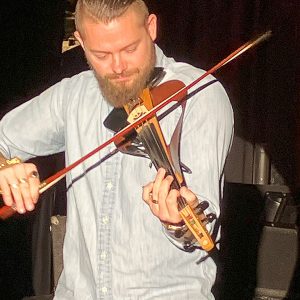 Modern Fiddle Player
Modern Fiddle Player 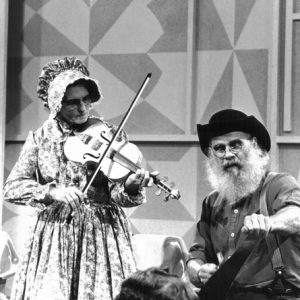 Violet Hensley
Violet Hensley 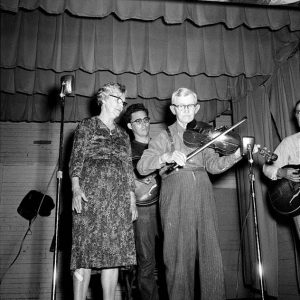 Almeda Riddle
Almeda Riddle 



Several years ago, I acquired an interesting fiddle that is obviously handmade, but very well done. I dont know if it is absolutely unique or if it represents a particular style.
Viewed through an f-hole is the pencil inscription, Mack Roulston, Russellville, Ark. In my research for provenance, I found a Mack C. Roulston born on August 10, 1901, and died on October 13, 1992, at the age of 91. Mack last resided in Russellville in Pope County. He was also known as McKinley Carl Mack Roulston as well as Roy McKinley Roulston. He is buried in Logan County.
I have found little else about Mack other than that he had two children who were simultaneously killed by a bolt of lightning in 1934. The childrens obituary had spelled his name Raulston, which caused some concern since then inscription in the fiddle (and on his gravestone) is Roulston. You will note that his marker has a fiddle and bow carved in it. To me this would indicate that he was considered a fiddler and/or a fiddle maker of some recognition.
I do not know if this instrument is one of a kind or if he made more, or if he was a local or regionally known musician. I keep the instrument in an old case that I later acquired somewhere else. They are a perfect marriage.